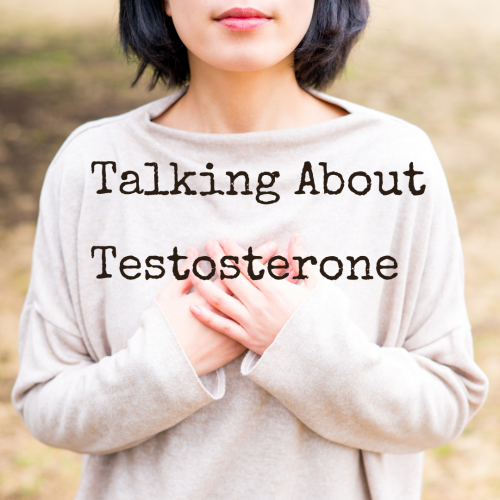Virginia Trioli welcomed me into her Chat Room at ABC Melbourne to discuss testosterone and perimenopause, it’s a discussion we need to be having. Let’s talk about this.
It’s topical right now, as in Australia a female testosterone product for women has been approved for the treatment of Hypoactive Sexual Desire Disorder (HSDD). This decision by the Therapeutic Goods Association (TGA) should be welcomed as a small step for womankind, but not accepted as nearly enough in addressing the gender bias in treatment of menopausal women.
Through my forties, I took symptoms of perimenopause, or fluctuating hormone levels to health professionals and be told to lower my stress levels or to take anti-depressants. I didn’t know they were symptoms of perimenopause and hormone deficiency and neither did the doctors I consulted. Menopause wasn’t even on my radar, the subject was a distant hurdle to jump somewhere in my fifties.
I was shocked at how little I understood about the lead up to menopause. And then, once perimenopause was identified, to find answers to any questions that challenged conventional medical thinking and get the treatment I needed. For me Hormone Replacement Therapy (HRT or MHT) of Oestrogen and Progesterone helped with the hot flushes and disrupted sleep, but not the debilitating lack of cognitive function or fatigue. I couldn’t understand why testosterone wasn’t part of menopausal hormone therapy and so started to review available data and academic research on the use of the so-called ‘male’ hormone, in women.
My investigation showed that testosterone and other related hormones in the body (also known as androgens) have important roles in healthy women. But there’s a common misperception that women’s bodies do not produce much testosterone. Yet it is the most abundant biologically active hormone throughout a woman’s lifespan. Through our lifetime (excluding pregnancy), women make 10 – 15 times more testosterone than oestrogen.
Testosterone levels drop in the years prior to and during menopause. This drop can lead to the onset of symptoms of ‘relative androgen deficiency’ including new mood disorders or worsening of existing ones, apathy, impaired glucose metabolism which leads to weight gain, insulin resistance/diabetes, fatigue, muscle wasting, bone loss, cognitive impairment, low libido, and other sexual function disorders.
Through our lifetime (excluding pregnancy), women make 10 – 15 times more testosterone than oestrogen
So I discovered enough to make me want to try this ‘male’ hormone to see if it would help with my loss of brain function and extreme fatigue. I was at the end of my tether, mentally and physically, I felt like I had lost the woman I once was. But I couldn’t get it from my GP, despite my blood levels being on the very low end of the scale. He said, ‘I’m unable to prescribe it for you.’ Eventually I found a doctor to prescribe it – you can find out more in a book I wrote about perimenopause.
Seven to ten days into testosterone therapy, my devastating brain fog began to clear and I started to feel far less fatigued. Months into treatment, my symptoms had turned around. I then became angry at how hard it is for women to access all the options to treat menopausal symptoms, and I questioned why testosterone therapy was so difficult for women to access. Men could access it but we couldn’t.
Why can’t we access this hormone?
It’s hard to access because of an intrinsic gender bias that women continue to suffer, it’s been prevalent for many years, and the circumstances continue to worsen with existing guidelines which outline the industry’s recommended approach to testosterone treatment for women. The Global Consensus Position Statement on the Use of Testosterone Therapy for Women was written by an international panel and published in 2019. They concluded the only evidence based indication for testosterone therapy for women is for the treatment of HSDD.
They said, ‘There are insufficient data to support the use of testosterone for the treatment of any other symptom or clinical condition, or for disease prevention.”
This is interesting because the data presented included selected industry-sponsored randomised controlled trials (RCTs) but excluded other research such as observational studies. Reconciling the results between the two is a challenge for clinical medicine and is important to understand. So I set about finding out more and found there was far more at play than it seems. That’s why I wrote The Naked Truth About PERIMENOPAUSE, Secret Menses Business. Not just for women, but for men too.
My book is designed to help women navigate their symptoms by getting educated and prepared, so they can make informed decisions to manage their hormonal health. And it will help those who love and support them to understand the challenges and sometimes odd behaviour caused by a rollercoaster hormonal retreat.
But the biggest contributing factor to me writing this book, and its point of difference to other menopause books is the information I share on testosterone and on accessing this controversial therapy.
My experience was that when I unknowingly entered the final year that led to menopause (aged 49), my cognitive function had declined to the point where I thought I might have dementia. I could barely process information or string my words together. Plus I was so exhausted I would dread having to get out of the car or walk up steps. Prior to this I was fairly fit. So my doctor tested me for other chronic diseases. If you want to find out what happened in my quest to try testosterone therapy click here.
Share your menopause story with us in our Facebook group, Secret Menses Business where women share experience, strength and hope in all areas of their lives. Follow my Facebook Page or read my book reviews here.


